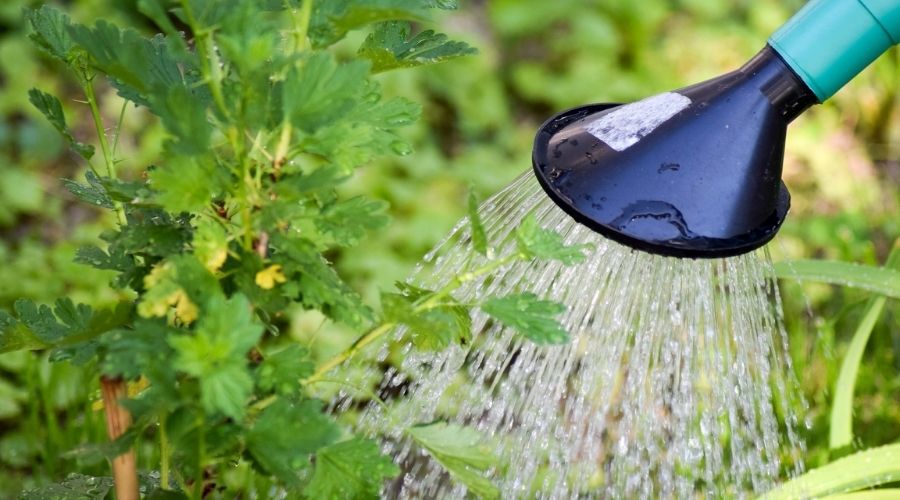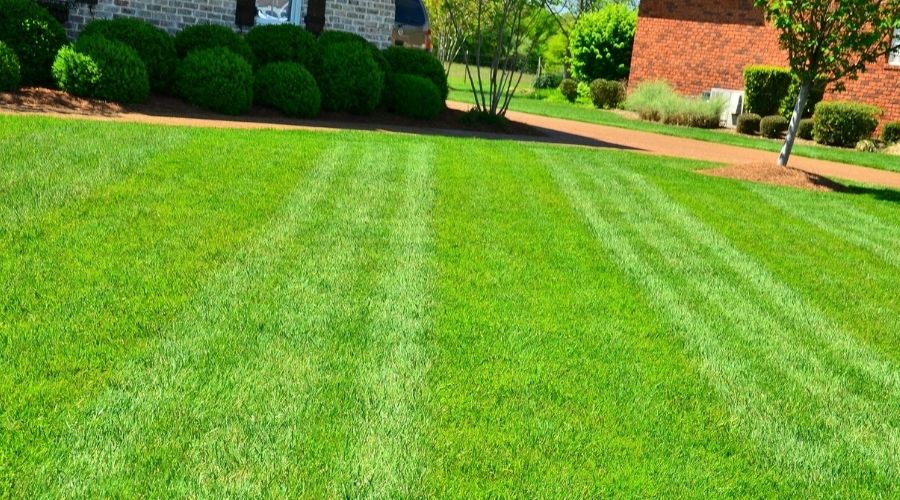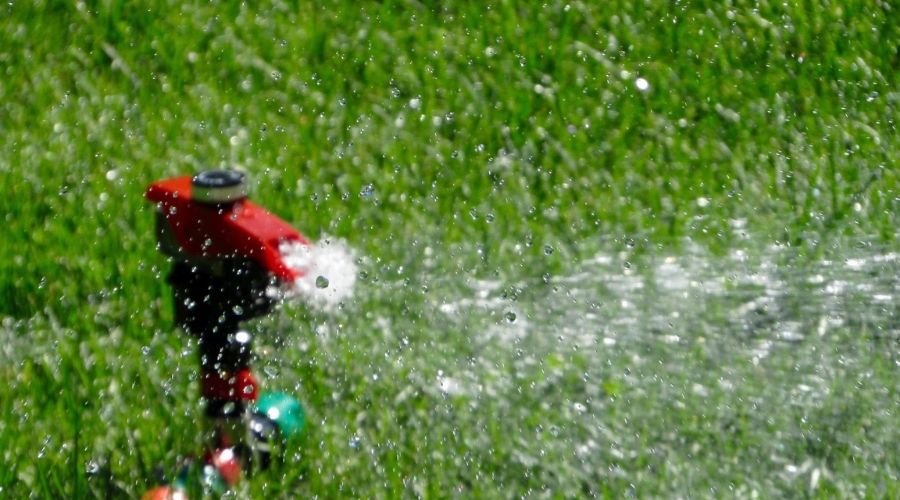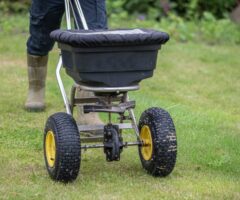The most critical time for your new plants’ and lawn’s survival is the first year after planting or installation. We’re often asked what you should do to ensure that new plants thrive in mid-Michigan’s growing conditions. Typical questions include:
- How much water do new plants need?
- How often should you water a new lawn?
- When can you start mowing a new lawn?
- Do newly-installed plants and lawns need to be fertilized?
- And many more!
Keep reading for our top tips to get your new perennials, shrubs, and lawn off to a great start so they’ll not only survive, they’ll grow into strong, healthy plants that enhance your landscape. You may also want to learn our ten tips for landscape maintenance during summer to keep your lawn healthy despite the heat, read it here.

Watering Tips for Newly-Planted Shrubs & Perennials
Why New Plants Need Special Care
Recently installed plants should be monitored carefully because they have not had a chance to establish roots in the surrounding soil. That means they have limited access to moisture and nutrients in the soil and will need your help to ensure they get what they need.
Keep in mind that new plants will need adequate and consistent moisture at the root ball (where the roots are), not just in the surrounding soil. Depending on the size of the plant, this can range from just a few inches below the soil surface to 12 inches or more for shrubs and ornamental trees.
How to Test Soil Moisture for New Plants
The best moisture meter is your fingers. Scrape back the mulch (you did cover the soil with mulch after planting, right?) and feel the soil.
- If it is hard and dry, water
- If it is soupy and soggy, stop watering.
- If it is moist, continue as you have been.
Take special care to examine the moisture level of the root ball (you may need to dig down 6 or more inches, without disturbing the roots, to check whether or not water is reaching the roots). During hot, windy, and/or sunny weather, moisture demand increases and additional hand watering may be needed to keep the root ball moist.
A sprinkler system alone may not provide enough moisture to the root ball of new plants. Frequent, shallow watering (such as for lawns) usually doesn’t allow moisture to soak deep enough into the soil to reach the roots of larger plants.
How Often to Monitor Soil Moisture
New plants should be monitored for moisture two to three times a week. For established plants, check the soil moisture every one or two weeks.
After the first month or two, your new plant watering regimen may result in too much water. Established plants need only half the water that grass does.
Seasonal Changes in Water Needs
Plants have lower moisture requirements in the early spring and late fall which is during their slow-growth or no-growth periods. At these times, nature’s supply of moisture is usually adequate and your new plants won’t need much (if any) supplemental water.
Wind, heat, and sun decrease moisture in both the soil and in plant tissue. When these conditions are present (like during our hot summer weather), your newly-installed plants will likely need additional watering.
A Final Word
Proper watering is an area that generates the most concern for gardeners and questions for our plant experts. Unfortunately, there are no definite or one-size-fits-all answers. However, if you monitor your plants’ moisture levels carefully, you will be rewarded with lush, happy, healthy plants.

Watering, Mowing & Fertilizing Tips for New Lawns
Watering Your New Lawn
Keeping the soil moist is the most important step in caring for your newly seeded or hydroseeded lawn. If the soil dries out while the grass seed is germinating or new sod is forming roots, your lawn will die.
Water your new lawn every day. If you do not have an in-ground irrigation system, be sure to set up sprinklers where they’ll cover all of your new lawn area.
Moisture requirements can vary on the same site, with sunny areas needing more water than shady spots. Monitor your lawn throughout the day to see whether some areas get more sun and will therefore need more water.
Sun, wind, and heat increase moisture loss so keep an eye on the weather. During hot or dry conditions, you may need to water your newly-seeded lawn area three or four times a day to keep it moist.
Apply water to your new lawn only as fast as it can be readily absorbed by the soil. After a few minutes, there should be no water remaining on the surface. And always be careful to avoid washing away the soil or grass seed.
Avoid walking over the wet surface after watering. Not only will this compact the soil (and plants, including turfgrass, don’t grow well in compacted soil), but it will also damage emerging grass shoots.

Watering Your Established Lawn
As your newly seeded lawn becomes established, it is important that you alter your watering practices. When the grass stand begins to thicken, watering can be cut back to once or twice per day. When the grass is fully established, watering once a day or every other day is sufficient.
A daily watering of 1/8 inch – rain or shine – is usually sufficient for areas that receive full sun.
Noon is the best time to water lawns. If your schedule doesn’t allow midday watering, early morning is your second best option.
In-ground sprinkler systems are convenient but tend to make people complacent. Irrigation systems are similar to the cruise control on your car; they work great as long as the situation stays constant. However, when traffic gets heavy we need to make manual adjustments. Similarly, the programmed settings on your irrigation system will require periodic adjustments. As weather conditions change, so should your irrigation practices.
To determine settings for your system, place a pie tin on your lawn and measure how long it takes 1/8 inch to accumulate in the tin. Different zones may deliver different amounts of water, so be sure to check all areas.
If you don’t have a sprinkler system, monitor sun, wind, and heat conditions daily to determine moisture loss in your lawn. Irrigate your lawn as often as needed.
When & How to Start Mowing Your New Lawn
When 20% of the grass stand has reached a height of 2½ to 3½ inches, it’s time to mow.
Always allow the lawn to dry before mowing.
Sharp mower blades are essential for mowing, especially for new seedlings.
Set your mower blades to a height of 2 to 3 inches and maintain the grass at this height until the lawn is established.
Don’t cut off more than 1/3 of the grass blade. This means you may need to mow your newly established lawn up to two or three times weekly.
If practical, we suggest that you collect the clippings from the first mowing or two, but it’s not really necessary.
Mowing your Established Lawn
The latest university research on mowing heights says, “Mow your lawn as high as you can stand it.” Warm soil causes all mid-Michigan grasses to slow their growth. The easiest way to keep the soil and grass roots cool is to provide shade from longer grass blades. Short-mowed grass requires more water, more fertilizer, and makes it easier for weeds to gain a foothold.
So, what does this translate to in inches?
Mow your lawn at 3” to 4” on the short side, and up to 5” and 5-1/2” on the high end. Yes, really!
Mow often enough to remove no more than 1/3 of the leaf blade at a time.
Leave the clippings on your lawn. Clippings decompose and supply nutrients to your lawn. One season of leaving clippings equals one application of fertilizer. Despite what you may have heard, lawn clippings do not cause thatch!
Fertilizing Your New Lawn
If Bay Landscaping installed your lawn, it was fertilized at the time of seeding or when the sod was laid. We recommend another light fertilizing after the lawn has been mowed the first time. This forces the grass to grow and spread into a thick turf.
Thereafter, we recommend four or five applications per year using a complete slow-release fertilizer each time.
Weed Control for New Lawns
While your new lawn is establishing itself, resist the urge to use a weed killer, even if weeds pop up. Once the lawn is fully established, use weed control only when needed by following directions on the product label.
Need a Hand?
Bay Landscaping offers an excellent landscape fertilization, weed management, and pest control program at an affordable price. Our experts provide custom lawn service to suit your needs (although we don’t mow lawns).
For the do-it-yourselfer, Bay Landscaping’s staff is happy to discuss types of fertilizers, how much to use, fertilizing equipment, and timing with you. We can also provide you with the professional products to do the job yourself. You can also buy our custom grass seed blends online or at our nursery in Essexville, MI.
Give us a call – we are here to help you.






